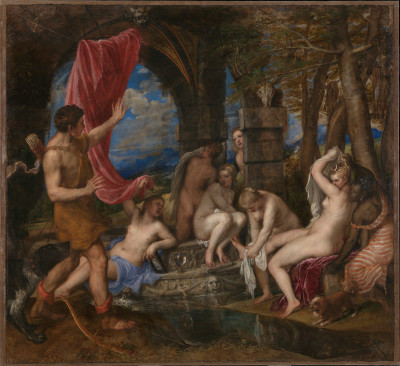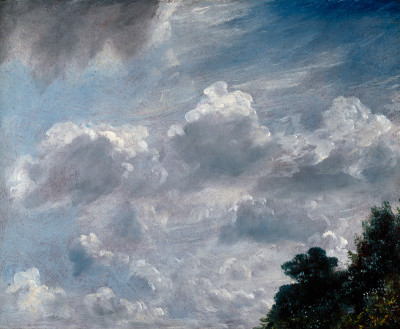Six ways the Napoleonic Wars changed British art
Six ways the Napoleonic Wars changed British art
By Annette Wickham
Published 18 June 2015
The conflict blocked artists from travelling – but also led to a boom in the art market and the arrival of works by Titian and van Eyck. As a wave of commemorations marks Waterloo’s 200th anniversary, our Curator of Works on Paper explains.
-
In September we exhibit Daniel Maclise’s cartoon for The Meeting of Wellington and Blücher. Explore the work online in our interactive.
Before the Napoleonic Wars, British art had seen great expansion. Following the birth of the Royal Academy in 1768, the professional status of artists was raised and the demand for contemporary art – by leading lights such as William Blake, Henry Fuseli and JMW Turner – was soaring. By the end of the 18th century there were more artists in this country, and more commissions, than ever before. Then came the Napoleonic wars, the French Emperor’s imperial ambitions spreading conflict across Europe for almost two decades (c.1799-1815) before Britain’s eventual triumph under the Duke of Wellington at the Battle of Waterloo. The wars naturally had a widespread impact on both British and French society, but also affected art and artists in sometimes unexpected ways. Here’s what happened this side of the Channel.
-
-
1. Artists bolted to France
During the 18th century, aspiring artists were encouraged to study Classical and Renaissance art first hand in Europe; an itinerary known as the “Grand Tour”. But the French Revolution and spread of the Napoleonic Wars across Europe meant that the continent was almost out of bounds to British travellers for over two decades. But a break in fighting between 1802-3 known as the “Peace of Amiens” saw artists from Britain flocking to Paris to see the French royal collections and the treasures from all over Europe amassed by Napoleon.Among them was JMW Turner, who headed south to the Alps and even set foot in Italy. The landscape and culture of Italy were pivotal to his work, but he had to wait until after the Battle of Waterloo in 1815 before he could visit the country again. As a result, Turner and many other landscape artists turned their attention to locations within the British Isles in the meantime (see Dolbadern Castle, right). Some artists hurried to France only to get stuck there. The watercolourist and scientist Thomas Richard Underwood was briefly taken prisoner at Calais when Napoleon ordered the arrest of all British males in the country aged between 18 and 60.

-
-
-

2. The London art market boomed
The wars in Europe transformed the British art market. During the French Revolution many aristocratic art collections were broken up as their owners fled the country or were sent to the guillotine. The subsequent occupation of many European cities and states by Napoleon – especially Rome – also meant that important works of art, and sometimes entire collections, were seized, sold or otherwise dispersed. Within this flurry of redistribution, London emerged as a trading centre for the international art market. Highly valuable works by some of Europe’s most famous artists – once rarely seen in Britain – were soon flooding the market.One of the most famous examples is the collection of Philippe, Duke of Orléans, with paintings by the likes of Rubens, Titian and Caravaggio. After changing hands several times in France, most of the collection was brought to London in 1793 by a French count – and caused a sensation when it was publicly exhibited in London. Old Master paintings of this quality were rarely seen outside private collections and were mostly known via prints. The author and critic William Hazlitt wrote that when he saw the works “a new heaven and a new Earth stood before me.” Examples from the collection such as Titian’s Diana and Actaeon (below) can now be found in major public and private collections across the UK.
Another iconic example is The Arnolfini Marriage by Jan van Eyck (left), now in the National Gallery. In the 19th century, a Scottish soldier claimed to have bought this enigmatic Netherlandish painting from the owner of the Brussels lodging house in which he convalesced after the Battle of Waterloo. Suspicion has been cast on his story, however, because he also fought in the Peninsular War in Spain and it seems more likely that he acquired the painting from their royal collection through less respectable means. After the Battle of Vitoria in 1813, British troops helped themselves to the contents of a coach abandoned by King Joseph Bonaparte (Napoleon’s elder brother) as he fled – including paintings, prints and drawings.
-
-
3. Artists built careers on commemoration
The end of the Napoleonic Wars, and particularly the final victory over Napoleon at the Battle of Waterloo naturally led to a slew of commemorative commissions. St. Paul’s Cathedral became a pantheon of monuments to national heroes and at Windsor Castle, King George IV created the Waterloo Chamber filled with portraits by Sir Thomas Lawrence of the major figures involved in the defeat of Napoleon.Turner was one of the first artists to paint the battle of Waterloo itself (below) but some artists made a whole career out of military scenes, like George “Waterloo” Jones – who had served in Wellington’s army and also oddly bore a strong resemblance to the Duke. The American artist and President of the Royal Academy, Benjamin West (who, like Smirke and Banks above, was also accused of being a democrat for a while) produced a commemorative painting and print depicting the heroic death of Lord Nelson (below); they proved wildly popular and earned West an impressive £3000.
One of the best-received paintings commemorating Waterloo does not show the battle itself but instead depicts a group of people reading about the victory in the papers. Sir David Wilkie’s painting Chelsea Pensioners reading the Gazette of the Battle of Waterloo (1818-22) was commissioned by the Duke of Wellington and when it was shown at the Royal Academy annual exhibition in 1822 required a barrier to protect it from the admiring throng of viewers.
-

Titian, Diana and Actaeon, 1556-9.

James Northcote, Portrait of Thomas Banks RA, 1792.

After Benjamin West, The Death of Lord Viscount Nelson, Line engraving.

Joseph Mallord William Turner RA, The Field of Waterloo, c.1818.
-
4. Art became political
While some British artists commemorated national heroes, there was also a growing market for satirical, often subversive, visual commentary on current affairs, and several high-profile artists held politically radical beliefs.Following the American War of Independence and the French Revolution, King George III and his court were gripped with paranoia about the rise of anti-monarchist sentiment in Britain – and during the Napoleonic Wars, the King became concerned that “disaffection and anarchy” were rife at the Royal Academy. A few well-known Academicians certainly had “democratical” sympathies. On hearing of Marie Antoinette’s death, Academician Robert Smirke was said to have remarked that “the Guillotine might well be employed upon some more crowned Heads”. In 1804 George III vetoed his appointment as Keeper of the RA Schools, apparently because of his politics.
The sculptor Thomas Banks was considered a “violent Democrat” and was arrested in 1794 on suspicion of treason. His last work, in 1803, was a bust of Oliver Cromwell. He submitted it to the RA annual (now Summer) exhibition but it was ordered to be removed, presumably to avoid any upsetting the institution’s royal patron.
-
5. Commemoration came round again…
In the years after Waterloo, unsurprisingly people began to tire of the subject. However, in the mid-19th century, the project to fill the new Houses of Parliament with grand art works celebrating the nation’s history gave the theme renewed relevance and reflection – as did the death of the Duke of Wellington in 1852 and the 50th anniversary of the battle of Waterloo in 1865. Waterloo and Napoleonic subjects enjoyed a particular revival in the late 19th century with paintings like Lady Butler’s Scotland Forever (1881, Leeds Art Gallery) and the work of Ernest Crofts RA.Daniel Maclise RA produced his cartoon for The Meeting of Wellington and Blücher in 1858-59, over 40 years after the battle of Waterloo itself. Going on show at the RA in September after conservation, it’s a full-scale preparatory drawing for a wall-painting (below) in the Royal Gallery of the House of Lords were it hangs opposite Maclise’s painting of the Death of Nelson at Trafalgar.
-

Daniel Maclise RA, The Meeting of Wellington and Blücher after the Battle of Waterloo, 1861.
Water-glass wall painting. 285.8 × 3535.7 cm. House of Lords, Palace of Westminster, London. Parliamentary Art Collection.
-
In his lifetime, Napoleon was often represented in Britain as an ogre or tyrant – as shown in the current British Museum display – but many British liberals also idolised him, at least initially. Later depictions of Napoleon tended to represent him as a flawed hero, such as that by William Quiller Orchardson RA, who painted Napoleon on board the Bellerophon in 1880. As well as a large group of drawings for this painting, the Royal Academy collection includes some of Orchardson’s Napoleonic memorabilia – including a lock of the emperor’s hair.
6 …but not everyone loves a memorial
London’s Trafalgar Square and Waterloo Station are enduring reminders of Britain’s role in the Napoleonic Wars, but many commemorative art works had a limited shelf-life in terms of public appreciation – and others were ridiculed from the start. The Wellington Monument (1822, below) in London’s Hyde Park, for example, is topped by an 18 foot high bronze sculpture of a nude Achilles by Richard Westmacott RA. The fact that this huge muscular figure – which was Britain’s first public sculpture of a nude – was paid for by donations specifically from women led to a lot of ridicule. Have a look next time you’re in Hyde Park – and while you’re there, imagine The Wellington Arch with a large equestrian statue on top. This ode to the Duke of Wellington by Matthew Cotes Wyatt (below) was disliked by the public and removed in 1883.Maclise’s cartoon for The Meeting of Wellington and Blücher was taken down from the Royal Academy’s walls in the 1920s. It was in bad repair after being on display for decades but it was also considered very old-fashioned and, following the devastation of the First World War, the subject matter is unlikely to have held much appeal. It spent most of the 20th century in storage.
200 years on, many commemorative monuments remain across the UK – but, as exemplified by the traffic cone that keeps appearing on the head of the Duke of Wellington’s equestrian statue in Glasgow’s Royal Exchange Square, they’re still not to everyone’s tastes.
-

Richard Westmacott RA, Achilles; the Wellington Monument at Hyde Park Corner, 1822.

Bedford Lemere & Co., Photograph of the Wellington Arch from Constitution Hill, 1882.

Statue of Wellington, mounted, Glasgow
-
Daniel Maclise: The Waterloo Cartoon is at the Royal Academy of Arts from 2 September – 3 January 2016.
Explore the work online now in our new interactive













